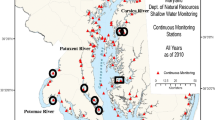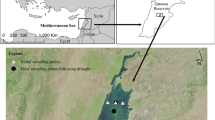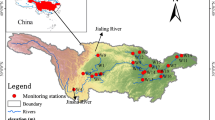Abstract
Dissolved oxygen is a critical component of river water quality. This study investigated average weekly dissolved oxygen (AWDO) and average weekly water temperature (AWT) in the Savannah River during 2015 and 2016 using data from the Intelligent River® sensor network. Weekly data and seasonal summary statistics revealed distinct seasonal patterns that impact both AWDO and AWT regardless of location along the river. Within seasons, spatial patterns of AWDO and AWT along the river are also evident. Linear mixed effects models indicate that AWT and low and high river flow conditions had a significant impact on AWDO, but added little predictive information to the models. Low and high river flow conditions had a significant impact on AWT, but also added little predictive information to the models. Spatial linear mixed effects models yielded parameter estimates that were effectively the same as non-spatial linear mixed effects models. However, components of variance from spatial linear mixed effects models indicate that 23–32% of the total variance in AWDO and that 12–18% of total variance in AWT can be apportioned to the effect of spatial covariance. These results indicate that location, week, and flow-directional spatial relationships are critically important considerations for investigating relationships between space- and time-varying water quality metrics.


Similar content being viewed by others
References
Bahr, D. L., & Peterson, D. L. (2016). Recruitment of juvenile Atlantic sturgeon in the Savannah River, Georgia. Transactions of the American Fisheries Society, 145, 1171–1178.
Bednarek, A. T., & Hart, D. D. (2005). Modifying dam operations to restore rivers: Ecological response to Tennessee River dam mitigation. Ecological Applications, 15(3), 997–1008.
Bianchi, T. S., DiMarco, S. F., Cowan Jr., J. H., Hetland, R. D., Chapman, P., Day, J. W., & Allison, M. A. (2010). The science of hypoxia in the Northern Gulf of Mexico: A review. Science of the Total Environment, 408, 1471–1484.
Cox, B. A. (2003). A review of dissolved oxygen modelling techniques for lowland rivers. The Science of the Total Environment, 314-316, 303–334.
Detenbeck, N. E., Morrison, A. C., Abele, R. W., & Kopp, D. A. (2016). Spatial statistical network models for stream and river temperature in New England, USA. Water Resources Research, 52, 6018–6040. https://doi.org/10.1002/2015WR018349.
Eidson, G. W., Esswein, S. T., Gemmill, J. B., Hallstrom, J. O., Howard, T. R., Lawrence, J. K., Post, C. J., Sawyer, C. B., Wang, K. C., & White, D. L. (2010). The South Carolina digital watershed: End-to-end support for real-time management of water resources. International Journal of Distributed Sensor Networks, 6, 970868. https://doi.org/10.1155/2010/970868.
Ensign, S. H., Hupp, C. R., Noe, G. B., Krauss, K. W., & Stagg, C. L. (2014). Sediment accretion in tidal freshwater forests of the Oligohaline marshes of the Waccamaw and Savannah Rivers, USA. Estuaries and Coasts, 37, 1107–1119.
ESRI. (2014). ArcGIS Desktop: Version 10.3. Redlands: Environmental Systems Research Institute.
Ficklin, D. L., Stewart, I. T., & Maurer, E. P. (2013). Effects of climate change on stream temperature, dissolved oxygen, and sediment concentration in the Sierra Nevada in California. Water Resources Research, 49, 2765–2782.
Harvey, R., Lye, L., Khan, A., & Paterson, R. (2011). The influence of air temperature on water temperature and the concentration of dissolved oxygen in Newfoundland Rivers. Canadian Water Resources Journal, 36, 171–192.
He, J., Chu, A., Ryan, M. C., Valeo, C., & Zaitlin, B. (2011). Abiotic influences on dissolved oxygen in a riverine environment. Ecological Engineering, 37, 1804–1814.
Holmes, R. (2017). USGS: Flood Frequency Q and A. https://water.usgs.gov/floods/events/2015/Joaquin/HolmesQA.html. Accessed 7 July 2017.
Huang, Y., & Scmitt, F. G. (2013). Time dependent intrinsic correlation analysis of temperature and dissolved oxygen time series using empirical mode decomposition. Journal of Marine Systems, 130, 90–100.
Ignatius, A. R., & Rasmussen, T. C. (2016). Small reservoir effects on headwater water quality in the rural-urban fringe, Georgia Piedmont, USA. Journal of Hydrology: Regional Studies, 8, 145–161.
Ingram, E. C., & Peterson, D. L. (2016). Annual spawning migrations of adult Atlantic sturgeon in the Altamaha River, Georgia. Marine and Coastal Fisheries., 8, 595–606 Intelligent River® Web Portal. https://www.intelligentriver.org/data. Accessed on 4 Mar 2017.
Isaak, D. J., Luce, C. H., Rieman, B. E., Nagel, D. E., Peterson, E. E., Horan, D. L., Parkes, S., & Chandler, G. L. (2010). Effects of climate change and wildfire on stream temperatures and salmonid thermal habitat in a mountain river network. Ecological Applications, 20, 1350–1371.
Jahn, S., & Srezov, V. (2017). Water quality assessment of Australian ports using water quality evaluation indices. PLoS One, 12(12), e0189284. https://doi.org/10.1371/journal.pone.0189284.
Kaushal, S. S., Likens, G. E., Jaworski, N. A., Pace, M. L., Sides, A. M., Seekell, D., Belt, K. T., Secor, D. H., & Wingate, R. L. (2010). Rising stream and river temperatures in the United States. Frontiers in Ecology and the Environment, 8, 461–466.
Kieser, M. S., Spoelstra, J. A., Feng Feng, A., James, W., & Li, Y. (2004). Storm water thermal enrichment in urban watersheds. London: International Water Association.
Kramer, D. L. (1987). Dissolved oxygen and fish behavior. Environmental Biology of Fishes, 18(2), 81–92.
Mandal, P., Upadhyay, R., & Hasan, A. (2010). Seasonal and spatial variation of Yamuna River water quality in Delhi, India. Environmental Monitoring and Assessment, 170, 661–670.
Mast, M. A., Murphy, S. F., Clow, D. W., Penn, C. A., & Sexstone, G. A. (2016). Water-quality response to a high-elevation wildfire in the Colorado Front Range. Hydrological Processes, 30, 1811–1823.
Minaudo, C., Meybeck, M., Moatar, F., Gassama, N., & Curie, F. (2015). Eutrophication mitigation in rivers: 30 years of trends in spatial and seasonal patterns of biogeochemistry of the Loire River (1980–2012). Biogeosciences, 12, 2549–2563.
Ozaki, N., Fukushima, T., Harasawa, H., Kojiri, T., Kawashima, K., & Ono, M. (2003). Statistical analyses on the effects of air temperature fluctuations on river water qualities. Hydrological Processes, 17, 2837–2853.
Peterson, E. E. (2015). STARS: Spatial Tools for the Analysis of River Systems Version 2.0.4—a Tutorial. Brisbane: Queensland University of Technology, Gardens Point Campus.
Price, K., & Leigh, D. S. (2006). Comparative water quality of lightly- and moderately-impacted streams in the southern Blue Ridge Mountains, USA. Environmental Monitoring and Assessment, 120, 269–300.
Qian, Y., Migliaccio, K. W., Wan, Y., Li, Y. C., & Chin, D. (2007). Seasonality of selected surface water constituents in the Indian River Lagoon, Florida. Journal of Environmental Quality, 36, 416–425.
R Core Team. (2014). R: A language environment for statistical computing. Vienna: R Foundation for Statistical Computing.
Richards, R. P., & Baker, D. B. (2002). Trends in water quality in LEASEQ rivers and streams (Northwestern Ohio), 1975–1995. Lake Erie agricultural systems for environmental quality. Journal of Environmental Quality, 31, 90–96.
Schindler, D. E., Jankowski, K., A’mar, Z. T., & Holtgrieve, G. W. (2017). Two-stage metabolism inferred from diel oxygen dynamics in aquatic ecosystems. Ecosphere, 8, ecs2.1867.
Sharp, J. H., Yoshiyama, K., Parker, A. E., Schwartz, M. C., Curless, S. E., Beauregard, A. Y., Ossolinski, J. E., & Davis, A. R. (2009). A biogeochemical view of estuarine eutrophication: Seasonal and spatial trends and correlations in the Delaware Estuary. Estuaries and Coasts, 32, 1023–1043.
Sherson, L. R., Van Horn, D. J., Gomez-Velez, J. D., Crossey, L. J., & Dahm, C. N. (2015). Nutrient dynamics in an alpine headwater stream: Use of continuous water quality sensors to examine responses to wildfire and precipitation events. Hydrological Processes, 29, 3193–3207.
Steel, E. A., Sowder, C., & Peterson, E. E. (2016). Spatial and temporal variation of water temperature regimes on the Snoqualmie River network. Journal of the American Water Resources Association, 52, 769–787.
Tufford, D. L., McKellar Jr., H. N., & Hussey, J. R. (1998). In-stream nonpoint source nutrient prediction with land-use proximity and seasonality. Journal of Environmental Quality, 27, 100–111.
U.S. Army Corps of Engineers. (2013) Corps Lakes on the Savannah River. http://www.sas.usace.army.mil/Portals/61/docs/lakes/Lake_Compare_Online_Version.pdf. Accessed 15 Mar 2017.
Van Vliet, M. T. H., Franssen, W. H. P., Yearsly, J. R., Ludwig, F., Haddeland, I., Lettenmaier, D. P., & Kabat, P. (2013). Global river discharge and water temperature under climate change. Global Environmental Change, 23, 450–464.
Vega, M., Pardo, R., Barrado, E., & Deban, L. (1998). Assessment of seasonal and polluting effects on the quality of river water by exploratory data analysis. Water Resources, 32, 3581–3592.
Ver Hoef, J. M., & Peterson, E. E. (2010). A moving average approach for spatial statistical models of stream networks. Journal of the American Statistical Association, 105, 6–18.
Ver Hoef, J. M., Peterson, E. E., Clifford, D., & Shah, R. (2014). SSN: An R package for spatial statistical modeling on stream networks. Journal of Statistical Software, 56.
Webb, B. W., Hanna, D. M., Moore, R. D., Brown, L. E., & Nobilis, F. (2008). Recent advances in stream and river temperature research. Hydrological Processes, 22, 902–918.
White D. L., Esswein, S., Hallstrom, J. O., Ali, F., Parab, S., Eidson, G., & Gemmill, J. (2010). The Intelligent River ®: implementation of sensor web enablement technologies across three tiers of system architecture: Fabric, middleware, and application (pp. 340–348). 2010 International Symposium on Collaborative Technologies and Systems, CTS 2010.
Wilde, E. W., & Shealy, R. L. (1992). Chlorination and dechlorination of nuclear reactor cooling water. Water Resources, 26(4), 539–545.
Williams, R. J., White, C., Harrow, M. L., & Neal, C. (2000). Temporal and small-scale spatial variations of dissolved oxygen in the rivers Thames, Pang and Kennet, UK. The Science of the Total Environment, 251(252), 497–510.
Wilson, M. A., & Carpenter, S. R. (1999). Economic valuation of freshwater ecosystem services in the United States: 1971–1997. Ecological Applications, 9, 772–783.
Xia, M., Craig, P. M., Schaeffer, B., Stoddard, A., Liu, Z., Peng, M., & Mandrup-Poulsen, J. (2010). Influence of physical forcing on bottom-water dissolved oxygen within Caloosahatchee River Estuary, Florida. Journal of Environmental Engineering, 136, 1032–1044.
Young, S. P., & Isely, J. J. (2011). Striped Bass annual site fidelity and habitat utilization in J. Strom Thurmond Reservoir, South Carolina-Georgia. Transactions of the American Fisheries Society, 131, 828–837.
Zhao, P., Tang, X., Tang, J., & Wang, C. (2013). Assessing water quality of Three Gorges Reservoir, China, over a five-year period from 2006 to 2011. Water Resources Management, 27, 4545–4558.
Funding
Data and financial support was provided through NSF MRI Award CNS-1541917. Technical Contribution No. 6409 of the Clemson University Experiment Station. This material is based upon work supported by NIFA/USDA, under projects: SC-1700541.
Author information
Authors and Affiliations
Corresponding author
Rights and permissions
About this article
Cite this article
Post, C.J., Cope, M.P., Gerard, P.D. et al. Monitoring spatial and temporal variation of dissolved oxygen and water temperature in the Savannah River using a sensor network. Environ Monit Assess 190, 272 (2018). https://doi.org/10.1007/s10661-018-6646-y
Received:
Accepted:
Published:
DOI: https://doi.org/10.1007/s10661-018-6646-y




